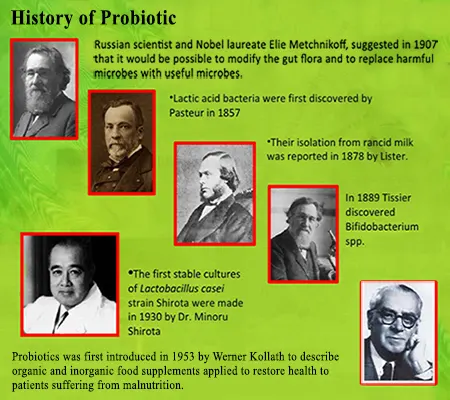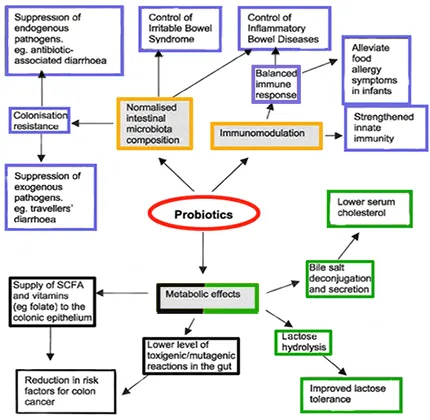Benefits of probiotics were discovered many years ago. The term “Probiotic” was derived from the Latin preposition pro (for) and the Greek noun bios (life) [1]. According to World Health Organization (WHO), Probiotic is “live microorganisms which, when administered in adequate amounts, provide a health benefit on the host”[2].
However, the word probiotic has been used in a number of different ways over the years (the chronicle of the evolution of the definition of probiotics). By the U.S. Food and Drug Administration, probiotics supplements are considered Generally Recognized As Safe (GRAS). Besides, it also includes different Pharmacopoeia.
Table of Contents
History of Probiotics

In 1907 Russian scientist and Nobel laureate Elie Metchnikoff suggested that it would be possible to replace harmful microbes with useful microbes in gut flora. After that, in 1953, Probiotics were first introduced by Werner Kollath. He was described as organic, and inorganic food supplements applied to restore health to the patients suffering from malnutrition.
Health benefits of Probiotics
Probiotics are very beneficial for the human body. When ingested in adequate amounts ingestion may confer the health benefits of Probiotics. Some benefits of probiotics are:
- Managing lactose intolerance
- Managing vaginal infection
- Preventing colon cancer
- Lowering cholesterol [3]
- Lowering blood pressure
- Preventing infections
- Improving immune function
- Treating constipation
- Treating antibiotics-associated diarrhea
- Treating and preventing eczema
- Treating childhood diarrhea
- Facilitate the management of a number of clinical conditions of diabetes [3].
- Reducing inflammation
- Improving mineral absorption
- Prevent harmful bacterial growth
- Prevent irritable bowel syndrome and colitis
The below image depicts the benefits of Probiotics

Figure: Benefits of Probiotics
Sources of Probiotics
Some common sources of probiotics are:
1. Yogurt: It is one of the most popular sources of probiotics. Yogurt is made from the milk of cows, goats, or sheep. In some countries, yogurt must contain a certain amount of probiotic bacteria. For example, in China, the requirement for the number of lactobacillus bacteria is at least 1 × 106 CFU per milliliter [4].
2. Miso Soup: It is one of the traditional medicine in Japan. It commonly uses in macrobiotic cooking as a digestive regulator. Miso soup is made from beans, rice or barley, and fermented rye, adding one tablespoon of miso to some hot water to make an excellent, quick, probiotic-rich soup.
3. Kefir: Kefir is a fermented dairy product. It is a combination of fermented kefir grains and goat’s milk. It is also rich in antioxidants.
4. Kombucha: Kombucha is a form of fermented tea that contains many healthy gut bacteria.
5. Cultured Vegetables (Sauerkraut and Kimchi): They are a combination of fermented cabbage and other vegetables. Sauerkraut is not probiotics but is high in organic acids that support the growth of good bacteria. Kimchi is the Korean food take on cultured veggies.
6. Microalgae: Microalgae refers to ocean-based plants (such as spirulina, chlorella, and blue-green algae) super-food.
7. Probiotic supplements manufactured by various pharmaceutical companies.
Dose of Probiotics
The health benefits of probiotics and the dose of probiotics are closely related. Studies show that the health benefits of probiotics have been observed at a dose of 1-40 billion bacteria per day, depending on selected probiotics, probiotics blend, and desire clinical outcome.
In conclusion, due to the incredible health benefits of probiotics, they are highly recommended. Besides, they have no severe side-effect. Moreover, a probiotic supplement is completely safe for pregnant women. There are no possibilities to overdose with probiotics. Therefore, they have been very popular recently.
Besides the health benefits of probiotics you may read: What are Probiotics? Example, Criteria, and Common Mechanism
References
- Hamilton-Miller JM, Gibson GR, Bruck W (2003). Some insights into the derivation and early uses of the word ‘probiotic’. Br. J. Nutr, 90 (4), 845.
- FAO/WHO. (2002). Guidelines for the evaluation of probiotics in food. Retrieved August 23, 2006.
- Sohag, M.S.U., Paul, M., Al-Bari, M.A.A., Wahed, M.I.I. and Khan, M.R.I. (2019) Potential Antidiabetic Activities of Probiotic Strains, L. acidophilus and L. bulgaricus against Fructose-Fed Hyperglycemic Rats. Food and Nutrition Sciences, 10, 1419-1432. https://doi.org/10.4236/fns.2019.1012101
- Lee, Yuan Kee et al. (2012). Probiotic Regulation in Asian Countries. In: Lahtinen, Sampo et al. (Eds.) (2012). Lactic Acid Bacteria: Microbiological and Functional Aspects, Fourth Edition. Boca Raton: CRC Press. ISBN 9780824753320. Page 712.